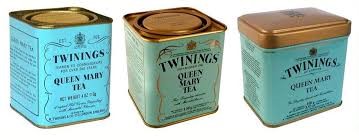When we think of Rye we remember the quirky cobbled streets, tales of smugglers and ghosts, its wealth of history and wonderful architecture but also its many quaint tea rooms all of which attract thousands of visitors each year. But have you ever wondered about the tea itself? Here, former Rye resident Michael Montagu takes us back in time and talks about some of the world’s most famous teas.
Twinings have been purveyors of fine teas since 1706. They have, no doubt, faced challenges during that time. Surely though, the quiet online campaign for the reintroduction of one of their favourite brands is a challenge to which they must submit. Since 2007 the perennial favourite, Queen Mary Blend, has been discontinued.
The distinctive and unique blend of Darjeeling and Keemun teas was first blended in 1916 and named in honour of the late Queen Elizabeth’s grandmother. Its preparation and serving were part of the time honoured tradition of Queen Mary’s favourite time of day, teatime. By the last few years of her life, Queen Mary ate very little, so her chef, Gabriel Tschumi, would ensure a regularly changing supply of the teatime favourites that he knew she was partial to.
Teatime at Marlborough House in London was at 4.30 pm promptly. To meet Queen Mary’s exacting standard of punctuality, everything except the tea itself was ready by 4.00 pm.
On days when no other guests were expected Queen Mary would have tea with her lady-in-waiting. At 4.30 pm precisely one of her two personal footmen would wheel a trolley laden with good things, sandwiches, scones, biscuits or cakes (but never all of them,) into Queen Mary’s first floor sitting room. Another trolley followed, this one with a silver kettle on its spirit lamp stand. Now all was ready for the making of the tea.
Queen Mary generally made the tea herself. The treasured leaves were kept in a locked jade caddy which stood in a small display cabinet with other jade items. Its key was kept in Her Majesty’s handbag. The rule was always one teaspoon per person and one for the pot. If the task was delegated to the lady-in-waiting it was always with the warning: “Level teaspoons. Don’t waste it now.”
Her Majesty liked routine, but her tea was never the same every day. That would have been considered dull. Woe betide her chef if he forgot that, as one of her notes to him showed. “Prefer the various small biscuits you make so well to the sponge cake fingers.” Queen Mary was fond of a light sponge but not every day. Her ladies-in-waiting were sometimes critical of the biscuits. One commented that biscuits Saxe-Weimar were “just a handful of coagulated sand”. Queen Mary’s notes, always written in pencil (pen was for letters) were always to the point but kindly worded, so that even a slight criticism would include some praise. To her, the appetite, no matter if small like hers, was something to be tempted and refreshed.
For her birthday a special sponge was always prepared, with chocolate ganache icing. It always comprised four layers for extra richness. The icing used a pint of cream. The latter was one of her particular indulgences. One of her favourites was an “everyday sponge, topped with strawberries and whipped cream”, according to Tschumi. For an Eton mess her instruction was: “Prefer whole strawberries with the real cream on top.” Cream again, and one of the items, along with butter, which were restricted on doctor’s orders in 1950. Then cream was banned from the table for luncheon and restricted to half a gill at dinner.
Sweet things were another weakness, with a large box of chocolates always open on the table in her sitting room. The soft centres were her favourites, much like her daughter-in-law, Queen Elizabeth, the Queen Mother. Queen Mary also bought small bars of chocolate from a shop in Mayfair’s Curzon Street, which she used to enjoy at odd hours of the day.
Queen Mary was probably what we now call a “Foodie”, in that she liked good food, well presented and served in season. Everything she ate was noted in the menu book, often with her pencilled comments: “Excellent”, “Great success”, “Repeat if possible” made after they had been served. Two items never appeared on her table: cheese and soup. With this latter she would be surprised to know that it was a dislike shared with another daughter-in-law, Wallis, Duchess of Windsor, who regarded it as “just another drink”. Queen Mary also liked to know the source of her food so instead of, for example, Grouses Rotis it would be Grouses Rotis de Balmoral. Obviously Her Majesty would have fitted in with the current trend to know the source of one’s food.
Image Credits: Michael Montagu .



